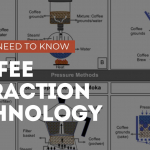Introduction: The Critical Bridge Between Harvest and Cup
The journey from coffee cherry to your morning cup involves numerous critical steps, each influencing the final flavor experience. While varieties, growing conditions, and roasting profiles receive significant attention, the processing method serves as the vital bridge between harvest and roast that fundamentally shapes a coffee’s flavor destiny.
For specialty coffee producers, roasters, and quality-focused farm managers, understanding the nuances of different processing techniques isn’t merely academic—it’s a strategic decision that affects everything from production costs to market positioning and, most importantly, the sensory experience delivered to consumers. Processing methods don’t just prepare coffee seeds for export; they create the foundation upon which all subsequent flavor development builds.
This comprehensive guide explores how washed, natural, and honey processing methods interact with coffee cherries to develop distinctive flavor characteristics, examines the technical requirements of each approach, and provides insights into selecting the optimal method based on your specific circumstances and goals.
Coffee Cherry Structure: Understanding the Canvas
Before diving into processing techniques, it’s essential to understand the structure of a coffee cherry and how each component contributes to flavor development.
A coffee cherry consists of several layers:
- Exocarp (Skin) – The outer red or yellow skin containing natural sugars and compounds
- Mesocarp (Pulp/Mucilage) – The sweet, sticky layer immediately beneath the skin, rich in sugars, pectins, and fermentable compounds
- Endocarp (Parchment) – A thin, paperlike protective layer surrounding the seed
- Silver Skin – A thin membrane adhering directly to the seed
- Seed (Bean) – The dense interior that becomes the coffee bean we roast
[IMAGE SUGGESTION 1: Cross-section diagram of a coffee cherry with all layers labeled]
Each processing method manipulates these components differently, allowing various compounds to interact with the seed during drying and fermentation. This interaction is what creates the distinctive flavor profiles associated with each technique.
Washed/Wet Process: Clarity and Bright Acidity
Step-by-Step Explanation
The washed process, also known as the wet process, is characterized by removing the cherry’s skin and pulp before drying the beans. Here’s the typical workflow:
- Harvesting – Selective picking of ripe cherries
- Floating/Sorting – Immersing cherries in water to separate lower-density, defective beans that float
- Depulping – Mechanical removal of the skin and most of the fruit pulp
- Fermentation – Submerging beans in water tanks for 12-36 hours to break down remaining mucilage through natural fermentation
- Washing – Thoroughly rinsing beans to remove all fermented mucilage
- Drying – Spreading beans on patios or raised beds until moisture content reaches approximately 10-12%
- Resting – Allowing beans to stabilize in their parchment for 30-60 days
- Hulling – Mechanical removal of the parchment layer
- Sorting and Grading – Separating beans by size, density, and quality
Flavor Characteristics
Washed coffees are prized for their:
- Clean, bright acidity – Often described as citric, malic, or phosphoric
- Clarity of flavor – Transparent expression of the bean’s inherent characteristics
- Distinct origin characteristics – Terroir expression is more pronounced
- Crisp, refined body – Generally lighter mouthfeel than other processing methods
- Floral, fruity, and herbal notes – Often displays delicate aromatics with nuanced complexity
Required Equipment and Infrastructure
The washed process requires significant infrastructure:
- Depulping machines
- Fermentation tanks
- Large quantities of clean water
- Washing channels or mechanical washers
- Extensive drying space (patios or raised beds)
- Water treatment facilities for environmentally responsible operations
Water Usage and Environmental Considerations
The washed process is water-intensive, typically requiring:
- 1,000-3,000 liters of water per ton of cherry processed
- Proper wastewater management to handle the high biological oxygen demand (BOD) from coffee pulp
- Treatment systems to neutralize acidic wastewater before release
Many progressive wet mills have implemented water recycling systems, mechanical mucilage removers to reduce fermentation water, and treatment facilities to mitigate environmental impact.
Traditional Regions
While now practiced globally, washed processing traditionally dominates in:
- Central America (Guatemala, Costa Rica, Honduras)
- Colombia
- Kenya
- Ethiopia (particularly Yirgacheffe and Sidamo regions)
- Rwanda and Burundi
These regions typically combine altitude, stable temperatures, and consistent rainfall that facilitate controlled fermentation and sufficient drying conditions.
Natural/Dry Process: Bold Body and Sweet Complexity
Step-by-Step Explanation
The natural process, the oldest coffee processing method, involves drying the entire cherry with the seed inside. The typical workflow includes:
- Harvesting – Selective picking of optimally ripe cherries (even more critical than for washed process)
- Floating/Sorting – Using water tanks to separate lower-density, defective cherries
- Initial Cleaning – Removing debris, leaves, and foreign matter
- Spreading – Laying cherries in thin layers on patios, raised beds, or drying tables
- Regular Turning – Rotating cherries 6-12 times daily to ensure uniform drying and prevent mold
- Covering – Protecting cherries from dew, rain, and excessive afternoon heat
- Drying – Allowing cherries to dry for 15-30 days until moisture content reaches approximately 10-12%
- Resting – Stabilizing dried cherries for 30-60 days
- Hulling – Mechanical removal of all dried cherry layers at once
- Sorting and Grading – Separating beans by size, density, and quality
Flavor Characteristics
Natural coffees typically exhibit:
- Heavy, syrupy body – Full mouthfeel with substantial presence
- Pronounced sweetness – Often reminiscent of tropical fruits, berries, or chocolate
- Complex fermented notes – Wine-like, brandy, or whiskey characteristics
- Reduced perceived acidity – Though still present, acidity is often rounded and integrated
- Bold fruit-forward profiles – Blueberry, strawberry, or mango notes are common, especially in Ethiopian naturals
- Rustic or earthy undertones – Sometimes displaying spice or wood notes
Required Equipment and Infrastructure
The natural process requires minimal equipment but substantial space:
- Extensive drying areas (patios, raised beds, or drying tables)
- Adequate covering materials for protection from elements
- Proper storage facilities for resting period
- Hulling machines designed for dry cherry removal
Climate Requirements and Challenges
Natural processing is highly dependent on climate conditions:
- Requires consistent dry weather with low humidity during the harvest season
- Optimal conditions include moderate temperatures (77-86°F/25-30°C) and relative humidity below 65%
- Insufficient airflow or excessive humidity can lead to mold development
- Inconsistent drying can result in fermentation defects or uneven flavor development
- Proper monitoring is labor-intensive, requiring constant attention to cherry condition
Traditional Regions
Natural processing traditionally flourishes in:
- Ethiopia (particularly Harrar and parts of Sidamo)
- Yemen
- Brazil (particularly Minas Gerais and Espírito Santo)
- Parts of Indonesia
- Western India
These regions typically combine either tradition, appropriate climatic conditions, or water scarcity that makes natural processing advantageous.
Honey/Pulped Natural Process: The Balanced Middle Path
Different Honey Process Variations
The honey process represents a spectrum of techniques between washed and natural methods, with variations categorized by “colors” indicating increasing levels of mucilage left on the bean and oxidation allowed during drying:
- White Honey – Minimal mucilage retention (approximately 10%)
- Yellow Honey – Moderate mucilage retention (approximately 25-50%)
- Red Honey – Substantial mucilage retention (approximately 50-75%)
- Black Honey – Maximum mucilage retention (75-100%) with extended drying in reduced sunlight
Step-by-Step Explanation of Each Variation
While specific techniques vary by producer, the general workflow follows:
White Honey Process:
- Harvesting selectively ripe cherries
- Floating/sorting to remove defective cherries
- Depulping to remove skins
- Mechanical washing to remove most mucilage (leaving approximately 10%)
- Rapid drying on patios or raised beds (typically 8-12 days)
- Resting, hulling, and sorting
Yellow Honey Process:
- Harvesting selectively ripe cherries
- Floating/sorting to remove defective cherries
- Depulping to remove skins
- Light mechanical washing to remove some mucilage (leaving approximately 25-50%)
- Controlled drying on patios or raised beds (typically 12-15 days)
- Resting, hulling, and sorting
Red Honey Process:
- Harvesting selectively ripe cherries
- Floating/sorting to remove defective cherries
- Depulping to remove skins only, preserving most mucilage (50-75%)
- Slow, controlled drying with limited sun exposure (typically 15-18 days)
- Resting, hulling, and sorting
Black Honey Process:
- Harvesting selectively ripe cherries
- Floating/sorting to remove defective cherries
- Gentle depulping to remove skins while preserving nearly all mucilage (75-100%)
- Very slow drying with minimal sun exposure, often covered for portions of the day (18-22 days)
- Extended resting period
- Hulling and sorting
Flavor Characteristics of Each Variation
White Honey:
- Bright acidity (similar to washed coffees)
- Enhanced sweetness compared to washed process
- Clean cup with mild fruit notes
- Medium body
- Subtle honey or caramel sweetness
Yellow Honey:
- Balanced acidity and body
- Pronounced sweetness with caramel and honey notes
- Mild fruit characteristics
- Smooth, round mouthfeel
- Good clarity with added complexity
Red Honey:
- Moderate acidity with pronounced sweetness
- Stone fruit or red berry notes
- Full, creamy body
- Complex sweetness resembling brown sugar or molasses
- Lingering, sweet finish
Black Honey:
- Subdued, integrated acidity
- Maximum sweetness with dark fruit notes
- Heavy, syrupy body
- Complex tropical fruit or berry characteristics
- Rich, wine-like fermented notes
- Long-lasting, sweet finish
Required Equipment and Infrastructure
Honey processing requires:
- Depulping machines with adjustable settings to control mucilage retention
- Extensive drying space with options for shade/sun control
- Mechanical mucilage removers (for white/yellow honey variations)
- Proper storage facilities for extended resting periods
- Advanced moisture monitoring equipment
The specific infrastructure needs scale with the “color” of honey process, with black honey requiring the most controlled conditions and monitoring.
Regions Gaining Popularity
Honey processing has gained significant traction in:
- Costa Rica (pioneer of modern honey processing)
- El Salvador
- Guatemala
- Brazil
- Colombia
- Panama
These regions typically combine sufficient infrastructure with growing specialty market connections that value the unique profiles honey processing delivers.
Comparative Analysis: Making Strategic Choices
[IMAGE SUGGESTION 2: Comparative chart showing the key differences between processing methods]
Flavor Profile Comparison
| Processing Method | Acidity | Body | Sweetness | Clarity | Complexity | Typical Flavor Notes |
|---|---|---|---|---|---|---|
| Washed | High, Bright | Light-Medium | Moderate | High | Focused | Citrus, Floral, Tea-like |
| White Honey | Medium-High | Medium | Medium-High | Medium-High | Medium | Honey, Caramel, Mild Fruit |
| Yellow Honey | Medium | Medium | High | Medium | Medium-High | Caramel, Stone Fruit, Nutty |
| Red Honey | Medium-Low | Medium-Full | Very High | Medium-Low | High | Red Fruits, Brown Sugar, Tropical |
| Black Honey | Low-Medium | Full | Maximum | Low | Very High | Dark Fruits, Wine-like, Molasses |
| Natural | Low-Medium | Full | Very High | Low | Complex | Berry, Fermented Fruit, Chocolate |
Processing Time and Labor Requirements
| Processing Method | Initial Processing Time | Drying Period | Labor Intensity | Monitoring Requirements |
|---|---|---|---|---|
| Washed | 1-3 days (fermentation) | 8-14 days | High | Medium |
| White Honey | 1 day | 8-12 days | Medium | Medium |
| Yellow Honey | 1 day | 12-15 days | Medium-High | High |
| Red Honey | 1 day | 15-18 days | High | Very High |
| Black Honey | 1 day | 18-22 days | Very High | Extremely High |
| Natural | 1 day | 15-30 days | Medium | Very High |
Equipment Requirements and Cost Considerations
| Processing Method | Initial Investment | Water Requirements | Energy Usage | Operating Costs | Environmental Impact |
|---|---|---|---|---|---|
| Washed | High | High | Medium-High | High | High (without treatment) |
| White Honey | Medium-High | Low-Medium | Medium | Medium | Low-Medium |
| Yellow Honey | Medium | Low | Medium | Medium | Low |
| Red Honey | Medium | Very Low | Low-Medium | Medium | Very Low |
| Black Honey | Medium | Very Low | Low | Medium-High | Very Low |
| Natural | Low | Minimal | Low | Low-Medium | Minimal |
Risk Factors
| Processing Method | Climate Sensitivity | Defect Risk | Consistency Challenges | Quality Control Difficulty |
|---|---|---|---|---|
| Washed | Medium | Low | Low | Low |
| White Honey | Medium | Low-Medium | Low-Medium | Low-Medium |
| Yellow Honey | Medium-High | Medium | Medium | Medium |
| Red Honey | High | Medium-High | Medium-High | High |
| Black Honey | Very High | High | High | Very High |
| Natural | Extremely High | High | High | High |
Modern Innovations in Processing Methods
The specialty coffee industry continues to evolve, introducing innovations that enhance quality, sustainability, and efficiency across all processing methods:
Washed Process Innovations
- Eco-pulpers – Machines that combine depulping and mechanical mucilage removal, reducing water usage by up to 90%
- Controlled fermentation – Using specific yeast strains or bacteria cultures to standardize fermentation profiles
- Anaerobic fermentation – Fermenting in sealed, oxygen-free environments to develop unique flavor profiles
- Extended fermentation – Carefully monitored 72+ hour fermentations to develop complex acidity profiles
- Water recycling systems – Closed-loop water management reducing environmental impact
Natural Process Innovations
- Temperature-controlled drying – Using greenhouses with ventilation systems to maintain optimal conditions
- Mechanical turning systems – Automated cherry movers that ensure consistent rotation
- Vacuum-sealed fermentation – Creating controlled environments for cherry fermentation before drying
- Shade nets with variable opacity – Providing precise light exposure control
- Moisture monitoring technology – Using digital systems to track drying progression accurately
Honey Process Innovations
- Adjustable depulping machines – Equipment that allows precise control of mucilage retention
- Controlled humidity drying rooms – Enclosed spaces with dehumidifiers for consistent drying regardless of weather
- Mucilage measurement tools – Devices that quantify the exact percentage of mucilage remaining
- Timed exposure protocols – Standardized schedules for sun/shade rotation to ensure consistency
- Fermentation additions – Using honey, specific yeasts, or other adjuncts to influence flavor development
Selecting the Right Processing Method: Strategic Considerations
Choosing the optimal processing method involves evaluating multiple factors:
Bean Variety and Terroir Considerations
- Varieties with floral characteristics (like Gesha) often shine with washed processing
- Varieties with inherent sweetness (like Pacamara) can excel with honey processing
- Terroirs producing beans with balanced attributes often have flexibility across methods
- High-acid terroirs might benefit from the sweetness-enhancing natural or honey methods
Climate and Environmental Factors
- Regions with consistent rainfall during harvest may require covered drying facilities for naturals
- Areas with high humidity need additional infrastructure for natural or honey processing
- Water-scarce regions may find economic and environmental benefits in dry or honey processing
- Altitude affects drying rates and fermentation dynamics, influencing optimal method selection
Market Positioning and Consumer Preferences
- Consider your target market’s flavor preferences (e.g., European markets traditionally favor washed coffees)
- Evaluate price premiums available for different processing methods in your market channels
- Assess whether your market values experimental profiles or traditional characteristics
- Consider storytelling opportunities each method provides for marketing purposes
Economic Realities
- Calculate initial investment requirements against available capital
- Project operational costs based on labor, energy, and resource availability
- Assess risk tolerance for climate-dependent methods
- Consider diversification across multiple methods to hedge against variable outcomes
Infrastructure and Expertise
- Honestly evaluate your team’s technical expertise with each method
- Consider your existing infrastructure and adaptation costs
- Assess quality control capabilities required for each method
- Evaluate training needs for staff to execute processes successfully
[IMAGE SUGGESTION 3: Decision tree flowchart to help producers select the right processing method based on their specific circumstances]
Conclusion: Processing as a Strategic Business Decision
The selection of coffee processing methods extends far beyond tradition or convenience—it represents a strategic business and quality decision with far-reaching implications. Each method creates distinctive sensory experiences that appeal to different market segments, requires varying levels of investment and expertise, and interacts uniquely with your specific growing environment.
For the specialty coffee producer, processor, or farm manager, processing methods offer powerful tools for differentiation in an increasingly competitive market. By understanding the technical requirements, flavor implications, and market positioning of each approach, you can make informed decisions that optimize your operation’s unique circumstances.
Whether pursuing the clean, bright profiles of washed coffees, the fruit-forward complexity of naturals, or the balanced sweetness of honey-processed beans, success lies in matching your processing approach to your specific beans, climate conditions, infrastructure capabilities, and target market preferences.
As climate change continues to affect growing conditions globally and consumer preferences evolve toward more diverse flavor experiences, the ability to adapt and perfect various processing methods will become an increasingly valuable competitive advantage. The producers who thrive will be those who view processing not merely as a post-harvest necessity but as a critical component of their quality strategy and brand identity.
The bridge between harvest and cup is yours to design—and the processing method you choose forms the foundation upon which all subsequent quality development builds.




